Emily Smith's Case: T2DM, Baker's Cyst, Medications, and Renal Health
VerifiedAdded on 2023/01/07
|10
|2906
|51
Case Study
AI Summary
This case study examines the health condition of Emily Smith, a 53-year-old patient diagnosed with Type 2 Diabetes Mellitus (T2DM) and Baker's cyst. The assignment delves into the pathophysiology of T2DM, including risk factors, pathogenesis, potential complications, and treatment levels. It differ...

Case Study
Paraphrase This Document
Need a fresh take? Get an instant paraphrase of this document with our AI Paraphraser
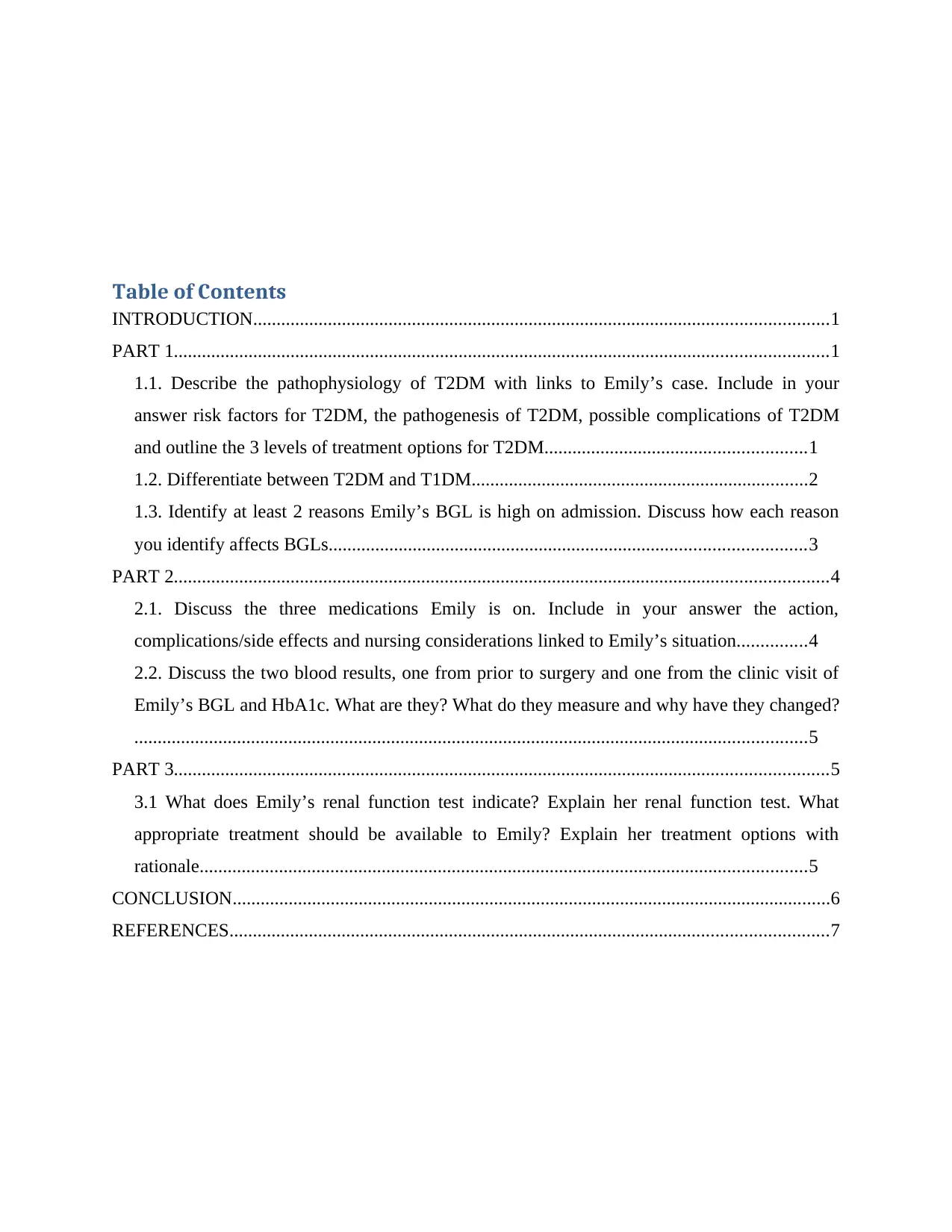
Table of Contents
INTRODUCTION...........................................................................................................................1
PART 1............................................................................................................................................1
1.1. Describe the pathophysiology of T2DM with links to Emily’s case. Include in your
answer risk factors for T2DM, the pathogenesis of T2DM, possible complications of T2DM
and outline the 3 levels of treatment options for T2DM........................................................1
1.2. Differentiate between T2DM and T1DM........................................................................2
1.3. Identify at least 2 reasons Emily’s BGL is high on admission. Discuss how each reason
you identify affects BGLs......................................................................................................3
PART 2............................................................................................................................................4
2.1. Discuss the three medications Emily is on. Include in your answer the action,
complications/side effects and nursing considerations linked to Emily’s situation...............4
2.2. Discuss the two blood results, one from prior to surgery and one from the clinic visit of
Emily’s BGL and HbA1c. What are they? What do they measure and why have they changed?
................................................................................................................................................5
PART 3............................................................................................................................................5
3.1 What does Emily’s renal function test indicate? Explain her renal function test. What
appropriate treatment should be available to Emily? Explain her treatment options with
rationale..................................................................................................................................5
CONCLUSION................................................................................................................................6
REFERENCES................................................................................................................................7
INTRODUCTION...........................................................................................................................1
PART 1............................................................................................................................................1
1.1. Describe the pathophysiology of T2DM with links to Emily’s case. Include in your
answer risk factors for T2DM, the pathogenesis of T2DM, possible complications of T2DM
and outline the 3 levels of treatment options for T2DM........................................................1
1.2. Differentiate between T2DM and T1DM........................................................................2
1.3. Identify at least 2 reasons Emily’s BGL is high on admission. Discuss how each reason
you identify affects BGLs......................................................................................................3
PART 2............................................................................................................................................4
2.1. Discuss the three medications Emily is on. Include in your answer the action,
complications/side effects and nursing considerations linked to Emily’s situation...............4
2.2. Discuss the two blood results, one from prior to surgery and one from the clinic visit of
Emily’s BGL and HbA1c. What are they? What do they measure and why have they changed?
................................................................................................................................................5
PART 3............................................................................................................................................5
3.1 What does Emily’s renal function test indicate? Explain her renal function test. What
appropriate treatment should be available to Emily? Explain her treatment options with
rationale..................................................................................................................................5
CONCLUSION................................................................................................................................6
REFERENCES................................................................................................................................7

You're viewing a preview
Unlock full access by subscribing today!
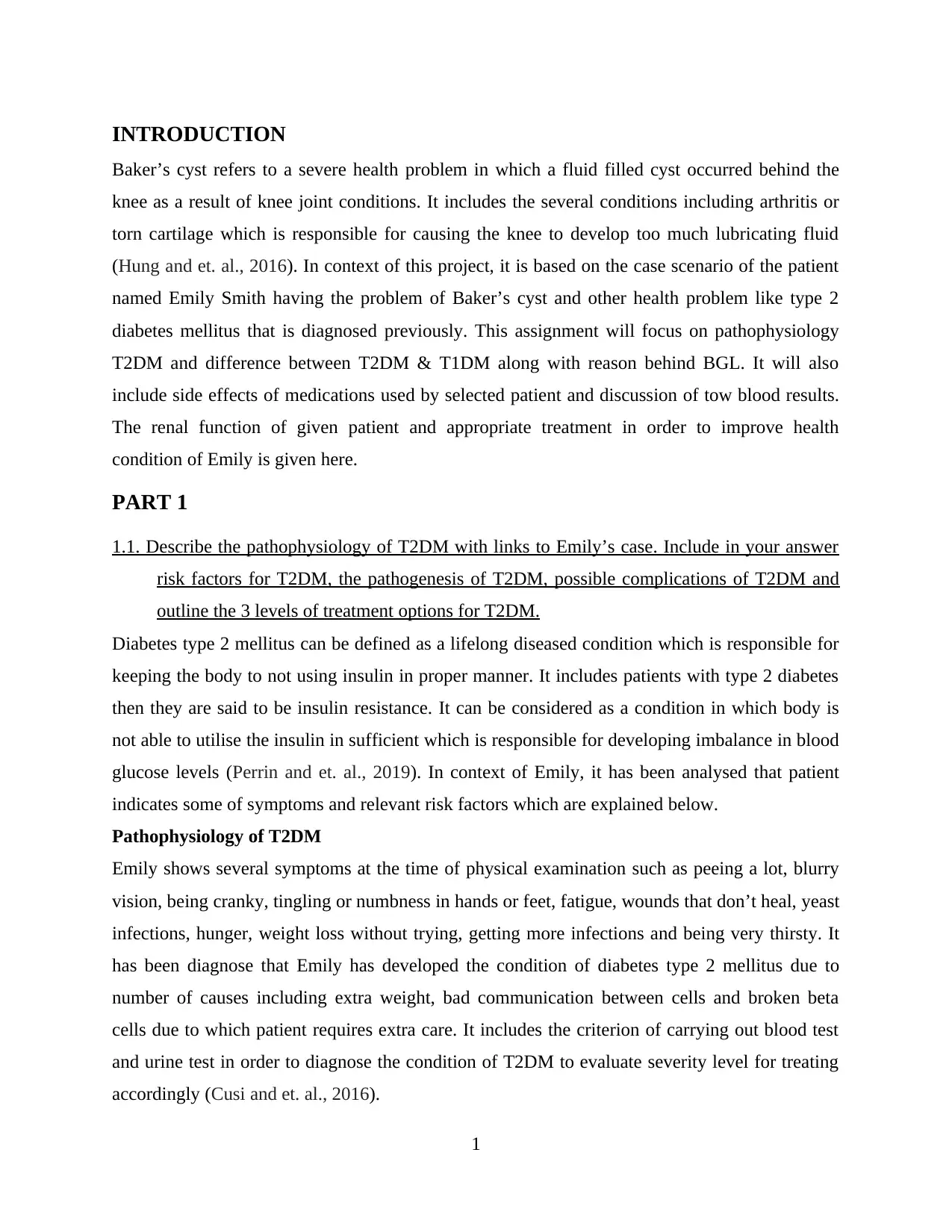
INTRODUCTION
Baker’s cyst refers to a severe health problem in which a fluid filled cyst occurred behind the
knee as a result of knee joint conditions. It includes the several conditions including arthritis or
torn cartilage which is responsible for causing the knee to develop too much lubricating fluid
(Hung and et. al., 2016). In context of this project, it is based on the case scenario of the patient
named Emily Smith having the problem of Baker’s cyst and other health problem like type 2
diabetes mellitus that is diagnosed previously. This assignment will focus on pathophysiology
T2DM and difference between T2DM & T1DM along with reason behind BGL. It will also
include side effects of medications used by selected patient and discussion of tow blood results.
The renal function of given patient and appropriate treatment in order to improve health
condition of Emily is given here.
PART 1
1.1. Describe the pathophysiology of T2DM with links to Emily’s case. Include in your answer
risk factors for T2DM, the pathogenesis of T2DM, possible complications of T2DM and
outline the 3 levels of treatment options for T2DM.
Diabetes type 2 mellitus can be defined as a lifelong diseased condition which is responsible for
keeping the body to not using insulin in proper manner. It includes patients with type 2 diabetes
then they are said to be insulin resistance. It can be considered as a condition in which body is
not able to utilise the insulin in sufficient which is responsible for developing imbalance in blood
glucose levels (Perrin and et. al., 2019). In context of Emily, it has been analysed that patient
indicates some of symptoms and relevant risk factors which are explained below.
Pathophysiology of T2DM
Emily shows several symptoms at the time of physical examination such as peeing a lot, blurry
vision, being cranky, tingling or numbness in hands or feet, fatigue, wounds that don’t heal, yeast
infections, hunger, weight loss without trying, getting more infections and being very thirsty. It
has been diagnose that Emily has developed the condition of diabetes type 2 mellitus due to
number of causes including extra weight, bad communication between cells and broken beta
cells due to which patient requires extra care. It includes the criterion of carrying out blood test
and urine test in order to diagnose the condition of T2DM to evaluate severity level for treating
accordingly (Cusi and et. al., 2016).
1
Baker’s cyst refers to a severe health problem in which a fluid filled cyst occurred behind the
knee as a result of knee joint conditions. It includes the several conditions including arthritis or
torn cartilage which is responsible for causing the knee to develop too much lubricating fluid
(Hung and et. al., 2016). In context of this project, it is based on the case scenario of the patient
named Emily Smith having the problem of Baker’s cyst and other health problem like type 2
diabetes mellitus that is diagnosed previously. This assignment will focus on pathophysiology
T2DM and difference between T2DM & T1DM along with reason behind BGL. It will also
include side effects of medications used by selected patient and discussion of tow blood results.
The renal function of given patient and appropriate treatment in order to improve health
condition of Emily is given here.
PART 1
1.1. Describe the pathophysiology of T2DM with links to Emily’s case. Include in your answer
risk factors for T2DM, the pathogenesis of T2DM, possible complications of T2DM and
outline the 3 levels of treatment options for T2DM.
Diabetes type 2 mellitus can be defined as a lifelong diseased condition which is responsible for
keeping the body to not using insulin in proper manner. It includes patients with type 2 diabetes
then they are said to be insulin resistance. It can be considered as a condition in which body is
not able to utilise the insulin in sufficient which is responsible for developing imbalance in blood
glucose levels (Perrin and et. al., 2019). In context of Emily, it has been analysed that patient
indicates some of symptoms and relevant risk factors which are explained below.
Pathophysiology of T2DM
Emily shows several symptoms at the time of physical examination such as peeing a lot, blurry
vision, being cranky, tingling or numbness in hands or feet, fatigue, wounds that don’t heal, yeast
infections, hunger, weight loss without trying, getting more infections and being very thirsty. It
has been diagnose that Emily has developed the condition of diabetes type 2 mellitus due to
number of causes including extra weight, bad communication between cells and broken beta
cells due to which patient requires extra care. It includes the criterion of carrying out blood test
and urine test in order to diagnose the condition of T2DM to evaluate severity level for treating
accordingly (Cusi and et. al., 2016).
1
Paraphrase This Document
Need a fresh take? Get an instant paraphrase of this document with our AI Paraphraser

Risk factors of T2DM
In context of Emily, it has been identified that several risk factors are associated with this case
for which suitable preventions are required to be considered by care professionals. It includes the
middle age condition of patient as she is 53 years old and the family because diabetes is a health
problem which is responsible from transmitting from one generation to the other. However, it
consist the fact that some of other risk factors are also possible such as heart & blood vessel
disease, high blood pressure, low HDL (good) cholesterol, high triglycerides, being overweight
or obese, gestational diabetes, polycystic ovary syndrome, depression and prediabetes (Scheen,
2017).
Pathogenesis of T2DM
In respect of given vase, it has been analysed that pathogenesis of type 2 diabetes mellitus
ordinarily contains the criterion of developing insulin resistance linked with compensatory
hyperinsulinemia. It is followed by progressive bet cell impairment which has outcome in
reduction of insulin secretion as well as hyperglycaemia.
Complications of T2DM
In context of given case, it has been examined that Emily may acquire several complications
related to type 2 diabetes mellitus if proper treatment and precautions were not taken. It includes
chance of occurring number of complication for given patient related to T2DM including
kidneys, eyes, nerves, skin, sleep, hearing, brain and heart & blood vessel problems (Teng and et.
al., 2018).
3 Levels of Treatment for T2DM
Level 1: The initial treatment is weight loss, healthy eating and regular exercise for managing the
glucose levels of blood.
Level 2: It includes use of several medicines such as metformin, sulfonylureas, meglitinides,
thiazolidinediones, DPP-4 inhibitors, GLP-1 receptor agonists and SGLT2 inhibitors (Wu and et.
al., 2017).
Level 3: It consist the use of insulin two times or more as per requirement of specific patient
condition and respective severity of D2DM.
1.2. Differentiate between T2DM and T1DM
Feature Type 1 Diabetes Type 2 Diabetes
2
In context of Emily, it has been identified that several risk factors are associated with this case
for which suitable preventions are required to be considered by care professionals. It includes the
middle age condition of patient as she is 53 years old and the family because diabetes is a health
problem which is responsible from transmitting from one generation to the other. However, it
consist the fact that some of other risk factors are also possible such as heart & blood vessel
disease, high blood pressure, low HDL (good) cholesterol, high triglycerides, being overweight
or obese, gestational diabetes, polycystic ovary syndrome, depression and prediabetes (Scheen,
2017).
Pathogenesis of T2DM
In respect of given vase, it has been analysed that pathogenesis of type 2 diabetes mellitus
ordinarily contains the criterion of developing insulin resistance linked with compensatory
hyperinsulinemia. It is followed by progressive bet cell impairment which has outcome in
reduction of insulin secretion as well as hyperglycaemia.
Complications of T2DM
In context of given case, it has been examined that Emily may acquire several complications
related to type 2 diabetes mellitus if proper treatment and precautions were not taken. It includes
chance of occurring number of complication for given patient related to T2DM including
kidneys, eyes, nerves, skin, sleep, hearing, brain and heart & blood vessel problems (Teng and et.
al., 2018).
3 Levels of Treatment for T2DM
Level 1: The initial treatment is weight loss, healthy eating and regular exercise for managing the
glucose levels of blood.
Level 2: It includes use of several medicines such as metformin, sulfonylureas, meglitinides,
thiazolidinediones, DPP-4 inhibitors, GLP-1 receptor agonists and SGLT2 inhibitors (Wu and et.
al., 2017).
Level 3: It consist the use of insulin two times or more as per requirement of specific patient
condition and respective severity of D2DM.
1.2. Differentiate between T2DM and T1DM
Feature Type 1 Diabetes Type 2 Diabetes
2

Definition People with diabetes type 1
lost ability of producing
insulin.
People with diabetes type 2
not able to respond or use the
insulin properly.
Onset Sudden Gradual
Age on set Any age
(mostly young)
Mostly in adults
Body habitus Thin or normal Often obese
Ketoacidosis Common Rare
Autoantibodies Usually present Absent
Endogenous insulin Low or present Normal, increased or
decreased
1.3. Identify at least 2 reasons Emily’s BGL is high on admission. Discuss how each reason you
identify affects BGLs.
The selected case of Emily has several reasons due to which increased blood sugar level can be
occurred due to which patient is required to remain extra conscious regarding their diet and
medications. It includes the initial reason of intake unhealthy diet including food items full of
glucose then it will results into increased blood sugar levels that impact negatively on health
condition. Meanwhile, the negligence in taking proper balanced diet and lack of precautions are
responsible for developing the severe health condition which need immediate medical attention
to regain the stable sugar level condition (Pollack and et. al., 2016). However, it is necessary for
Emily to remain extra conscious as well as careful while taking meals along with avoiding
overeating to avoid relevant complicated condition.
In addition to this, it has been analysed that second reason behind increased blood glucose level
is skipped medication which impact negatively on the health condition of an individual. It
includes the criterion of developing severe symptoms due to which patient may become
unconscious for some time which needs quick clinical attention so that care professionals should
monitor them regularly and encourage taking medicine timely.
3
lost ability of producing
insulin.
People with diabetes type 2
not able to respond or use the
insulin properly.
Onset Sudden Gradual
Age on set Any age
(mostly young)
Mostly in adults
Body habitus Thin or normal Often obese
Ketoacidosis Common Rare
Autoantibodies Usually present Absent
Endogenous insulin Low or present Normal, increased or
decreased
1.3. Identify at least 2 reasons Emily’s BGL is high on admission. Discuss how each reason you
identify affects BGLs.
The selected case of Emily has several reasons due to which increased blood sugar level can be
occurred due to which patient is required to remain extra conscious regarding their diet and
medications. It includes the initial reason of intake unhealthy diet including food items full of
glucose then it will results into increased blood sugar levels that impact negatively on health
condition. Meanwhile, the negligence in taking proper balanced diet and lack of precautions are
responsible for developing the severe health condition which need immediate medical attention
to regain the stable sugar level condition (Pollack and et. al., 2016). However, it is necessary for
Emily to remain extra conscious as well as careful while taking meals along with avoiding
overeating to avoid relevant complicated condition.
In addition to this, it has been analysed that second reason behind increased blood glucose level
is skipped medication which impact negatively on the health condition of an individual. It
includes the criterion of developing severe symptoms due to which patient may become
unconscious for some time which needs quick clinical attention so that care professionals should
monitor them regularly and encourage taking medicine timely.
3
You're viewing a preview
Unlock full access by subscribing today!
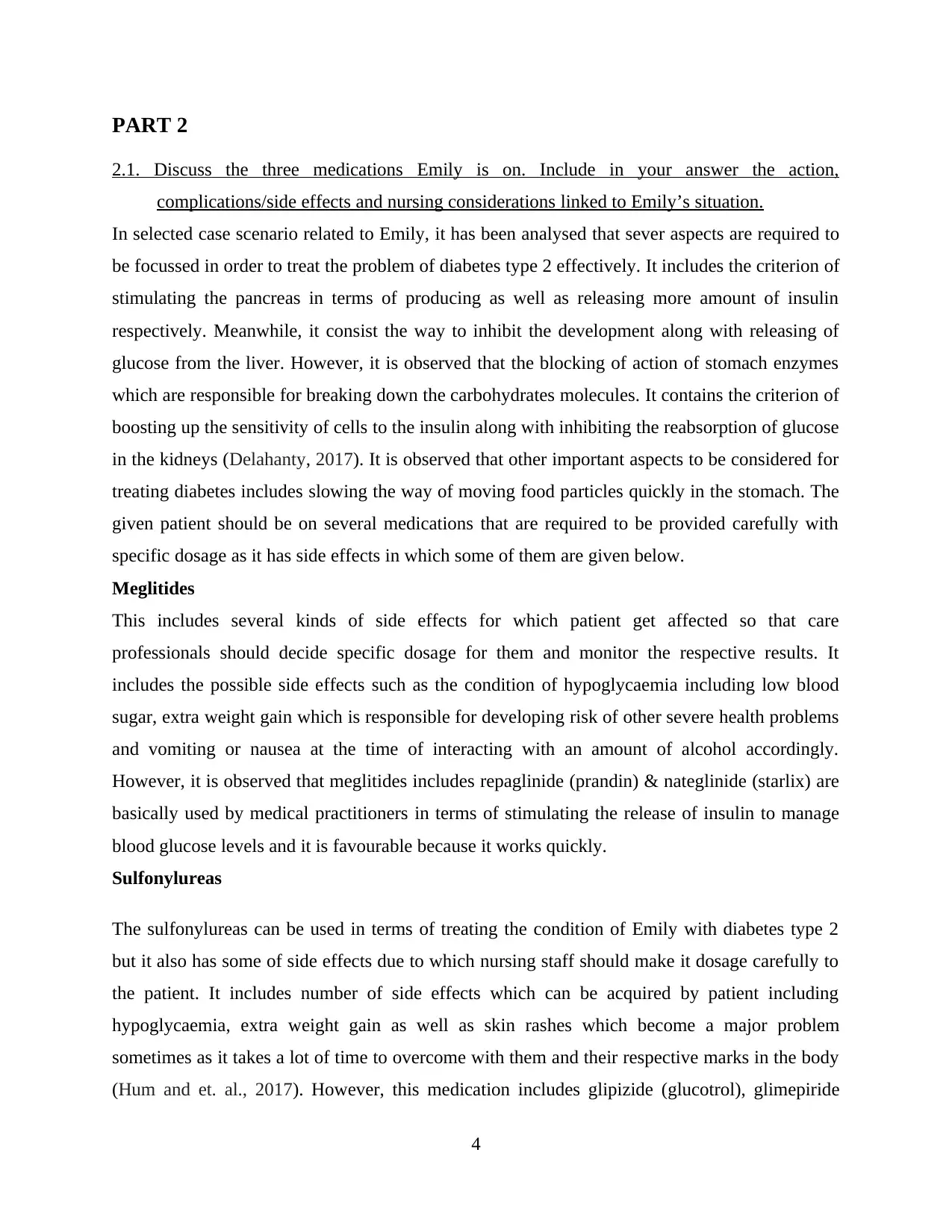
PART 2
2.1. Discuss the three medications Emily is on. Include in your answer the action,
complications/side effects and nursing considerations linked to Emily’s situation.
In selected case scenario related to Emily, it has been analysed that sever aspects are required to
be focussed in order to treat the problem of diabetes type 2 effectively. It includes the criterion of
stimulating the pancreas in terms of producing as well as releasing more amount of insulin
respectively. Meanwhile, it consist the way to inhibit the development along with releasing of
glucose from the liver. However, it is observed that the blocking of action of stomach enzymes
which are responsible for breaking down the carbohydrates molecules. It contains the criterion of
boosting up the sensitivity of cells to the insulin along with inhibiting the reabsorption of glucose
in the kidneys (Delahanty, 2017). It is observed that other important aspects to be considered for
treating diabetes includes slowing the way of moving food particles quickly in the stomach. The
given patient should be on several medications that are required to be provided carefully with
specific dosage as it has side effects in which some of them are given below.
Meglitides
This includes several kinds of side effects for which patient get affected so that care
professionals should decide specific dosage for them and monitor the respective results. It
includes the possible side effects such as the condition of hypoglycaemia including low blood
sugar, extra weight gain which is responsible for developing risk of other severe health problems
and vomiting or nausea at the time of interacting with an amount of alcohol accordingly.
However, it is observed that meglitides includes repaglinide (prandin) & nateglinide (starlix) are
basically used by medical practitioners in terms of stimulating the release of insulin to manage
blood glucose levels and it is favourable because it works quickly.
Sulfonylureas
The sulfonylureas can be used in terms of treating the condition of Emily with diabetes type 2
but it also has some of side effects due to which nursing staff should make it dosage carefully to
the patient. It includes number of side effects which can be acquired by patient including
hypoglycaemia, extra weight gain as well as skin rashes which become a major problem
sometimes as it takes a lot of time to overcome with them and their respective marks in the body
(Hum and et. al., 2017). However, this medication includes glipizide (glucotrol), glimepiride
4
2.1. Discuss the three medications Emily is on. Include in your answer the action,
complications/side effects and nursing considerations linked to Emily’s situation.
In selected case scenario related to Emily, it has been analysed that sever aspects are required to
be focussed in order to treat the problem of diabetes type 2 effectively. It includes the criterion of
stimulating the pancreas in terms of producing as well as releasing more amount of insulin
respectively. Meanwhile, it consist the way to inhibit the development along with releasing of
glucose from the liver. However, it is observed that the blocking of action of stomach enzymes
which are responsible for breaking down the carbohydrates molecules. It contains the criterion of
boosting up the sensitivity of cells to the insulin along with inhibiting the reabsorption of glucose
in the kidneys (Delahanty, 2017). It is observed that other important aspects to be considered for
treating diabetes includes slowing the way of moving food particles quickly in the stomach. The
given patient should be on several medications that are required to be provided carefully with
specific dosage as it has side effects in which some of them are given below.
Meglitides
This includes several kinds of side effects for which patient get affected so that care
professionals should decide specific dosage for them and monitor the respective results. It
includes the possible side effects such as the condition of hypoglycaemia including low blood
sugar, extra weight gain which is responsible for developing risk of other severe health problems
and vomiting or nausea at the time of interacting with an amount of alcohol accordingly.
However, it is observed that meglitides includes repaglinide (prandin) & nateglinide (starlix) are
basically used by medical practitioners in terms of stimulating the release of insulin to manage
blood glucose levels and it is favourable because it works quickly.
Sulfonylureas
The sulfonylureas can be used in terms of treating the condition of Emily with diabetes type 2
but it also has some of side effects due to which nursing staff should make it dosage carefully to
the patient. It includes number of side effects which can be acquired by patient including
hypoglycaemia, extra weight gain as well as skin rashes which become a major problem
sometimes as it takes a lot of time to overcome with them and their respective marks in the body
(Hum and et. al., 2017). However, this medication includes glipizide (glucotrol), glimepiride
4
Paraphrase This Document
Need a fresh take? Get an instant paraphrase of this document with our AI Paraphraser
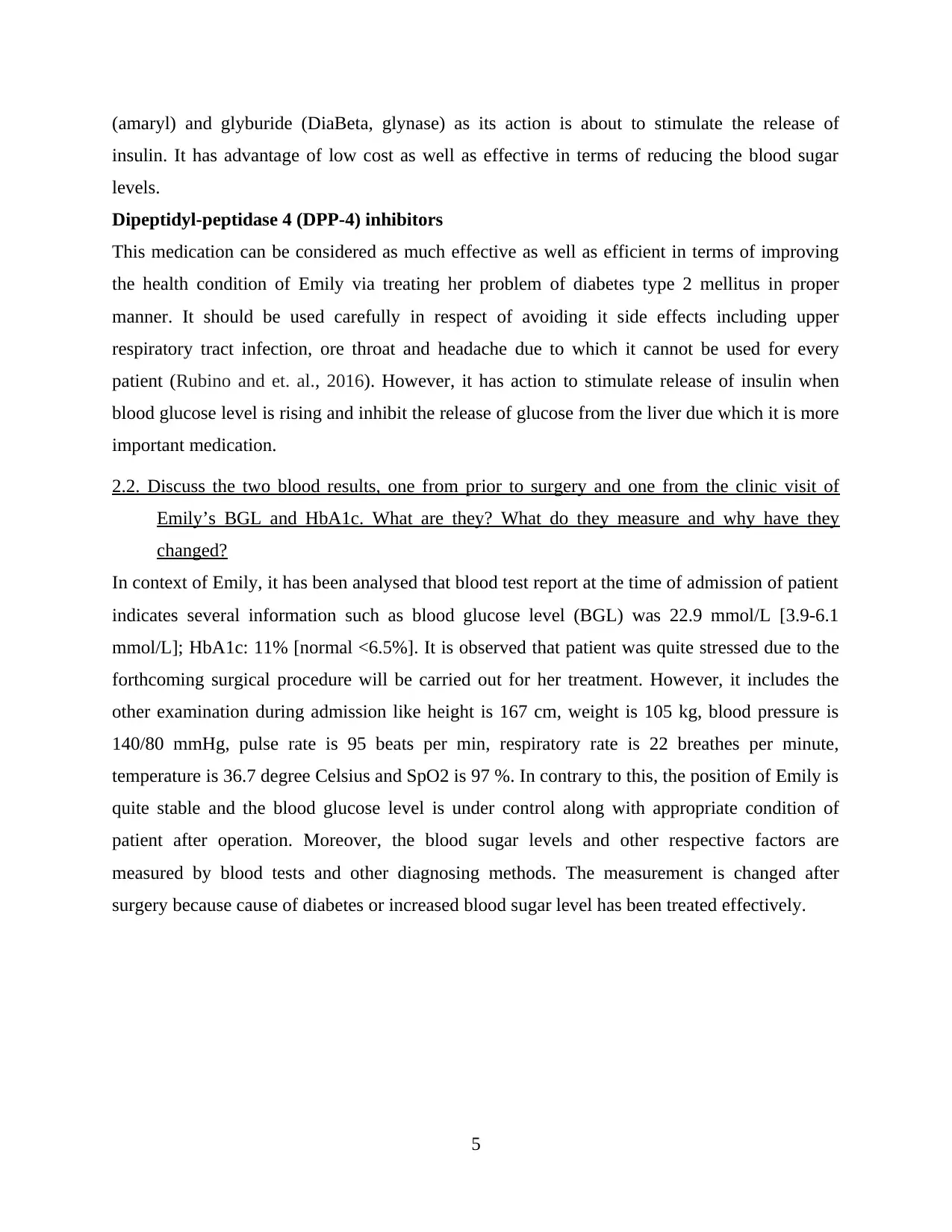
(amaryl) and glyburide (DiaBeta, glynase) as its action is about to stimulate the release of
insulin. It has advantage of low cost as well as effective in terms of reducing the blood sugar
levels.
Dipeptidyl-peptidase 4 (DPP-4) inhibitors
This medication can be considered as much effective as well as efficient in terms of improving
the health condition of Emily via treating her problem of diabetes type 2 mellitus in proper
manner. It should be used carefully in respect of avoiding it side effects including upper
respiratory tract infection, ore throat and headache due to which it cannot be used for every
patient (Rubino and et. al., 2016). However, it has action to stimulate release of insulin when
blood glucose level is rising and inhibit the release of glucose from the liver due which it is more
important medication.
2.2. Discuss the two blood results, one from prior to surgery and one from the clinic visit of
Emily’s BGL and HbA1c. What are they? What do they measure and why have they
changed?
In context of Emily, it has been analysed that blood test report at the time of admission of patient
indicates several information such as blood glucose level (BGL) was 22.9 mmol/L [3.9-6.1
mmol/L]; HbA1c: 11% [normal <6.5%]. It is observed that patient was quite stressed due to the
forthcoming surgical procedure will be carried out for her treatment. However, it includes the
other examination during admission like height is 167 cm, weight is 105 kg, blood pressure is
140/80 mmHg, pulse rate is 95 beats per min, respiratory rate is 22 breathes per minute,
temperature is 36.7 degree Celsius and SpO2 is 97 %. In contrary to this, the position of Emily is
quite stable and the blood glucose level is under control along with appropriate condition of
patient after operation. Moreover, the blood sugar levels and other respective factors are
measured by blood tests and other diagnosing methods. The measurement is changed after
surgery because cause of diabetes or increased blood sugar level has been treated effectively.
5
insulin. It has advantage of low cost as well as effective in terms of reducing the blood sugar
levels.
Dipeptidyl-peptidase 4 (DPP-4) inhibitors
This medication can be considered as much effective as well as efficient in terms of improving
the health condition of Emily via treating her problem of diabetes type 2 mellitus in proper
manner. It should be used carefully in respect of avoiding it side effects including upper
respiratory tract infection, ore throat and headache due to which it cannot be used for every
patient (Rubino and et. al., 2016). However, it has action to stimulate release of insulin when
blood glucose level is rising and inhibit the release of glucose from the liver due which it is more
important medication.
2.2. Discuss the two blood results, one from prior to surgery and one from the clinic visit of
Emily’s BGL and HbA1c. What are they? What do they measure and why have they
changed?
In context of Emily, it has been analysed that blood test report at the time of admission of patient
indicates several information such as blood glucose level (BGL) was 22.9 mmol/L [3.9-6.1
mmol/L]; HbA1c: 11% [normal <6.5%]. It is observed that patient was quite stressed due to the
forthcoming surgical procedure will be carried out for her treatment. However, it includes the
other examination during admission like height is 167 cm, weight is 105 kg, blood pressure is
140/80 mmHg, pulse rate is 95 beats per min, respiratory rate is 22 breathes per minute,
temperature is 36.7 degree Celsius and SpO2 is 97 %. In contrary to this, the position of Emily is
quite stable and the blood glucose level is under control along with appropriate condition of
patient after operation. Moreover, the blood sugar levels and other respective factors are
measured by blood tests and other diagnosing methods. The measurement is changed after
surgery because cause of diabetes or increased blood sugar level has been treated effectively.
5
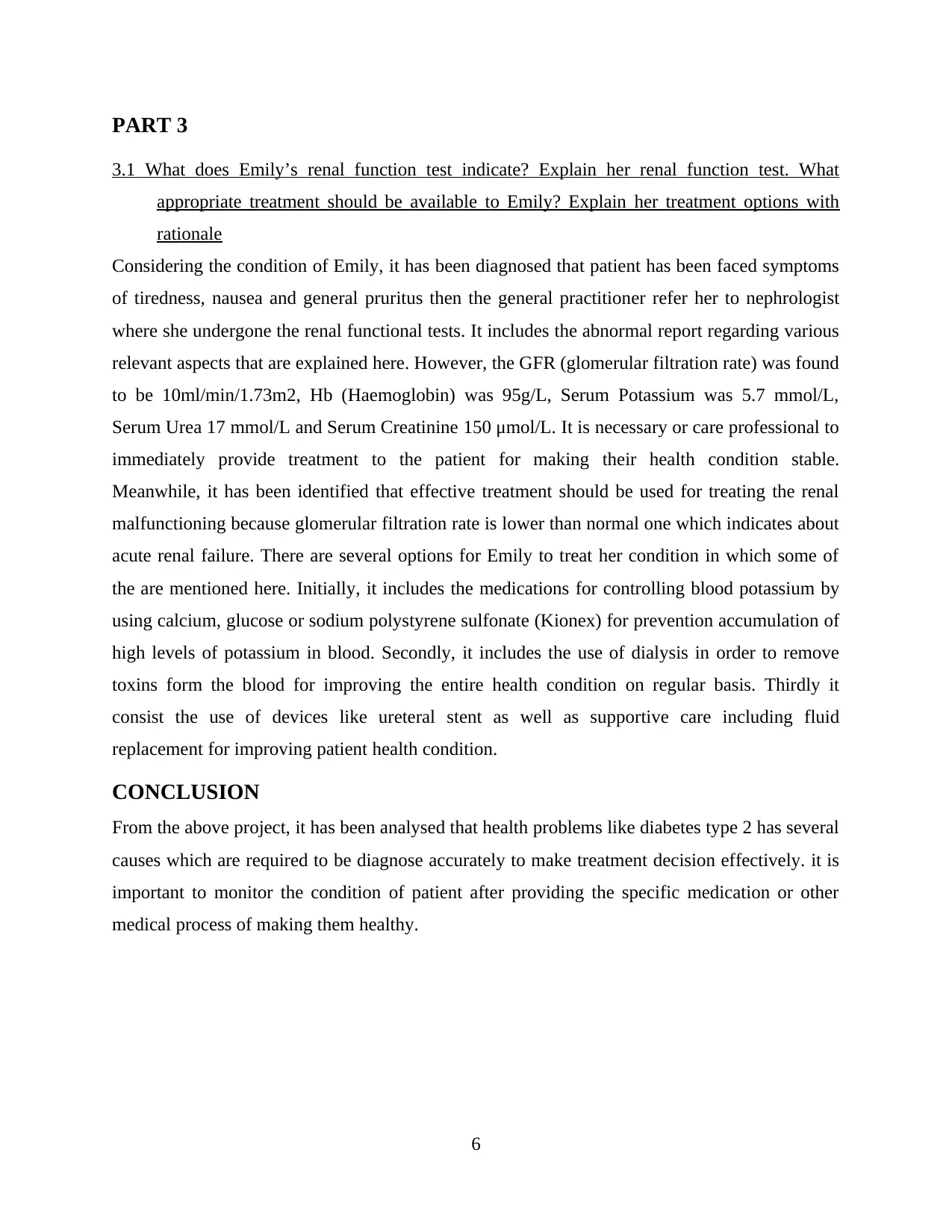
PART 3
3.1 What does Emily’s renal function test indicate? Explain her renal function test. What
appropriate treatment should be available to Emily? Explain her treatment options with
rationale
Considering the condition of Emily, it has been diagnosed that patient has been faced symptoms
of tiredness, nausea and general pruritus then the general practitioner refer her to nephrologist
where she undergone the renal functional tests. It includes the abnormal report regarding various
relevant aspects that are explained here. However, the GFR (glomerular filtration rate) was found
to be 10ml/min/1.73m2, Hb (Haemoglobin) was 95g/L, Serum Potassium was 5.7 mmol/L,
Serum Urea 17 mmol/L and Serum Creatinine 150 μmol/L. It is necessary or care professional to
immediately provide treatment to the patient for making their health condition stable.
Meanwhile, it has been identified that effective treatment should be used for treating the renal
malfunctioning because glomerular filtration rate is lower than normal one which indicates about
acute renal failure. There are several options for Emily to treat her condition in which some of
the are mentioned here. Initially, it includes the medications for controlling blood potassium by
using calcium, glucose or sodium polystyrene sulfonate (Kionex) for prevention accumulation of
high levels of potassium in blood. Secondly, it includes the use of dialysis in order to remove
toxins form the blood for improving the entire health condition on regular basis. Thirdly it
consist the use of devices like ureteral stent as well as supportive care including fluid
replacement for improving patient health condition.
CONCLUSION
From the above project, it has been analysed that health problems like diabetes type 2 has several
causes which are required to be diagnose accurately to make treatment decision effectively. it is
important to monitor the condition of patient after providing the specific medication or other
medical process of making them healthy.
6
3.1 What does Emily’s renal function test indicate? Explain her renal function test. What
appropriate treatment should be available to Emily? Explain her treatment options with
rationale
Considering the condition of Emily, it has been diagnosed that patient has been faced symptoms
of tiredness, nausea and general pruritus then the general practitioner refer her to nephrologist
where she undergone the renal functional tests. It includes the abnormal report regarding various
relevant aspects that are explained here. However, the GFR (glomerular filtration rate) was found
to be 10ml/min/1.73m2, Hb (Haemoglobin) was 95g/L, Serum Potassium was 5.7 mmol/L,
Serum Urea 17 mmol/L and Serum Creatinine 150 μmol/L. It is necessary or care professional to
immediately provide treatment to the patient for making their health condition stable.
Meanwhile, it has been identified that effective treatment should be used for treating the renal
malfunctioning because glomerular filtration rate is lower than normal one which indicates about
acute renal failure. There are several options for Emily to treat her condition in which some of
the are mentioned here. Initially, it includes the medications for controlling blood potassium by
using calcium, glucose or sodium polystyrene sulfonate (Kionex) for prevention accumulation of
high levels of potassium in blood. Secondly, it includes the use of dialysis in order to remove
toxins form the blood for improving the entire health condition on regular basis. Thirdly it
consist the use of devices like ureteral stent as well as supportive care including fluid
replacement for improving patient health condition.
CONCLUSION
From the above project, it has been analysed that health problems like diabetes type 2 has several
causes which are required to be diagnose accurately to make treatment decision effectively. it is
important to monitor the condition of patient after providing the specific medication or other
medical process of making them healthy.
6
You're viewing a preview
Unlock full access by subscribing today!
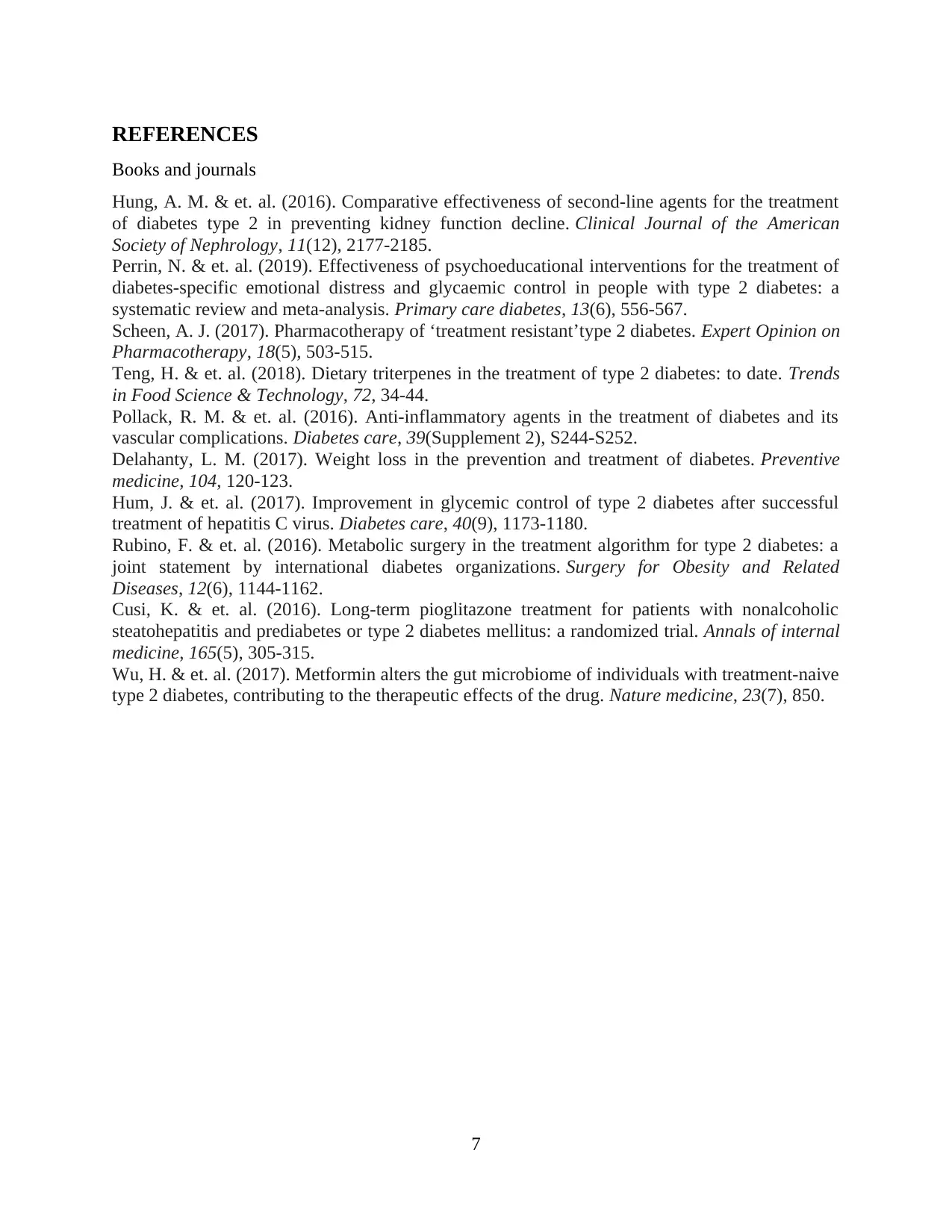
REFERENCES
Books and journals
Hung, A. M. & et. al. (2016). Comparative effectiveness of second-line agents for the treatment
of diabetes type 2 in preventing kidney function decline. Clinical Journal of the American
Society of Nephrology, 11(12), 2177-2185.
Perrin, N. & et. al. (2019). Effectiveness of psychoeducational interventions for the treatment of
diabetes-specific emotional distress and glycaemic control in people with type 2 diabetes: a
systematic review and meta-analysis. Primary care diabetes, 13(6), 556-567.
Scheen, A. J. (2017). Pharmacotherapy of ‘treatment resistant’type 2 diabetes. Expert Opinion on
Pharmacotherapy, 18(5), 503-515.
Teng, H. & et. al. (2018). Dietary triterpenes in the treatment of type 2 diabetes: to date. Trends
in Food Science & Technology, 72, 34-44.
Pollack, R. M. & et. al. (2016). Anti-inflammatory agents in the treatment of diabetes and its
vascular complications. Diabetes care, 39(Supplement 2), S244-S252.
Delahanty, L. M. (2017). Weight loss in the prevention and treatment of diabetes. Preventive
medicine, 104, 120-123.
Hum, J. & et. al. (2017). Improvement in glycemic control of type 2 diabetes after successful
treatment of hepatitis C virus. Diabetes care, 40(9), 1173-1180.
Rubino, F. & et. al. (2016). Metabolic surgery in the treatment algorithm for type 2 diabetes: a
joint statement by international diabetes organizations. Surgery for Obesity and Related
Diseases, 12(6), 1144-1162.
Cusi, K. & et. al. (2016). Long-term pioglitazone treatment for patients with nonalcoholic
steatohepatitis and prediabetes or type 2 diabetes mellitus: a randomized trial. Annals of internal
medicine, 165(5), 305-315.
Wu, H. & et. al. (2017). Metformin alters the gut microbiome of individuals with treatment-naive
type 2 diabetes, contributing to the therapeutic effects of the drug. Nature medicine, 23(7), 850.
7
Books and journals
Hung, A. M. & et. al. (2016). Comparative effectiveness of second-line agents for the treatment
of diabetes type 2 in preventing kidney function decline. Clinical Journal of the American
Society of Nephrology, 11(12), 2177-2185.
Perrin, N. & et. al. (2019). Effectiveness of psychoeducational interventions for the treatment of
diabetes-specific emotional distress and glycaemic control in people with type 2 diabetes: a
systematic review and meta-analysis. Primary care diabetes, 13(6), 556-567.
Scheen, A. J. (2017). Pharmacotherapy of ‘treatment resistant’type 2 diabetes. Expert Opinion on
Pharmacotherapy, 18(5), 503-515.
Teng, H. & et. al. (2018). Dietary triterpenes in the treatment of type 2 diabetes: to date. Trends
in Food Science & Technology, 72, 34-44.
Pollack, R. M. & et. al. (2016). Anti-inflammatory agents in the treatment of diabetes and its
vascular complications. Diabetes care, 39(Supplement 2), S244-S252.
Delahanty, L. M. (2017). Weight loss in the prevention and treatment of diabetes. Preventive
medicine, 104, 120-123.
Hum, J. & et. al. (2017). Improvement in glycemic control of type 2 diabetes after successful
treatment of hepatitis C virus. Diabetes care, 40(9), 1173-1180.
Rubino, F. & et. al. (2016). Metabolic surgery in the treatment algorithm for type 2 diabetes: a
joint statement by international diabetes organizations. Surgery for Obesity and Related
Diseases, 12(6), 1144-1162.
Cusi, K. & et. al. (2016). Long-term pioglitazone treatment for patients with nonalcoholic
steatohepatitis and prediabetes or type 2 diabetes mellitus: a randomized trial. Annals of internal
medicine, 165(5), 305-315.
Wu, H. & et. al. (2017). Metformin alters the gut microbiome of individuals with treatment-naive
type 2 diabetes, contributing to the therapeutic effects of the drug. Nature medicine, 23(7), 850.
7
1 out of 10
Related Documents
Your All-in-One AI-Powered Toolkit for Academic Success.
+13062052269
info@desklib.com
Available 24*7 on WhatsApp / Email
![[object Object]](/_next/static/media/star-bottom.7253800d.svg)
Unlock your academic potential
© 2024 | Zucol Services PVT LTD | All rights reserved.





